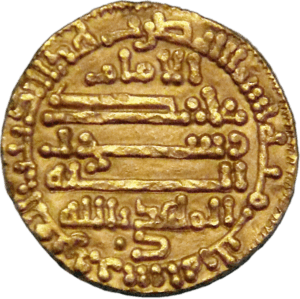Abdallah al-Mahdi Billah facts for kids
Quick facts for kids al-Mahdi Billahالمهدي بالله |
|||||
|---|---|---|---|---|---|

Gold dinar of Caliph al-Mahdi, Kairouan, 912 CE
|
|||||
| Caliph of the Fatimid Dynasty | |||||
| Reign | November 909 – 3 April 934 | ||||
| Successor | al-Qa'im Bi-Amrillah | ||||
| Born | Sa'id 31 July 873 or 874 Khuzestan/Salamiya |
||||
| Died | 3 April 934 (aged 59-60) Mahdiya |
||||
| Issue | al-Qa'im Bi-Amrillah | ||||
|
|||||
| Dynasty | Fatimid | ||||
| Father | al-Husayn (Abu Abdallah az-Zaki) | ||||
| Religion | Isma'ili Shia Islam | ||||
Abu Muhammad Ubayd Allah ibn al-Husayn (873 – 4 March 934), known as al-Mahdi Billah, was a very important leader in Islamic history. He founded the Fatimid Caliphate, a powerful empire that lasted for over 200 years. He was also considered the eleventh Imam in the Isma'ili branch of Shia Islam.
Contents
Who Was Al-Mahdi Billah?
Al-Mahdi Billah was born in 873 or 874 CE. His birth name was Sa'id. He was born in either Khuzestan or Salamiya, which are regions in the Middle East. He grew up in a time when many different groups were trying to gain power.
His Religious Background
Al-Mahdi belonged to the Ismaili branch of Shia Islam. In this faith, an Imam is a spiritual leader who is believed to be a descendant of the Prophet Muhammad. Al-Mahdi was seen as the eleventh Imam by his followers. He also claimed to be the "Mahdi," a figure in Islamic belief who will appear to restore justice and righteousness.
Starting the Fatimid Caliphate
In the early 10th century, al-Mahdi's followers helped him rise to power. He traveled from Syria to North Africa. There, he found strong support among the local people. This support allowed him to challenge the existing rulers.
Rise to Power in North Africa
Al-Mahdi arrived in what is now Tunisia. He was helped by a powerful leader named Abu Abdallah al-Shi'i. Together, they overthrew the Aghlabid dynasty, which had ruled the area. This victory marked the beginning of the Fatimid Caliphate.
What is a Caliphate?
A caliphate is a type of Islamic state led by a caliph. A caliph is seen as a successor to the Prophet Muhammad. They hold both religious and political authority. The Fatimid Caliphate was unique because it was the only major Shia caliphate in history. Most other caliphates were Sunni.
Building a New Capital: Mahdia
After establishing his rule, al-Mahdi decided to build a new capital city. He chose a coastal location in Tunisia. This city was named Mahdia, after him. It was designed to be a strong fortress, protected by the sea on three sides. Mahdia became a major center for trade and learning.
What Was the Fatimid Caliphate?
The Fatimid Caliphate grew to be a very large and important empire. It eventually controlled much of North Africa, Egypt, and parts of the Middle East. It was known for its strong navy and its focus on trade.
A Center of Learning and Culture
The Fatimids encouraged learning and art. They built grand mosques and libraries. They also supported scholars and scientists. Their capital cities, like Mahdia and later Cairo in Egypt, became famous for their beautiful architecture and intellectual life.
Al-Mahdi's Legacy
Al-Mahdi Billah ruled for about 25 years, from 909 to 934 CE. He laid the foundation for a powerful and long-lasting dynasty. His actions changed the political and religious map of the Islamic world. He is remembered as the founder of a unique and influential empire.
See Also
 In Spanish: Abdullah al-Mahdi Billah para niños
In Spanish: Abdullah al-Mahdi Billah para niños

